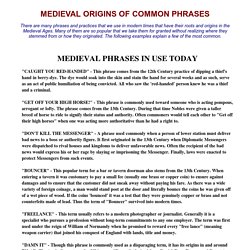

Medieval English Names. As the spelling of English was not standardized during the Middle Ages, names can be found in many different forms in written records.

The French diminutive endings which arrived with the Normans (‘-et’, ‘-in’ and ‘-on’ ) became less common and English forms such as ‘-cock’, and ‘-kin’ took their place. Double diminutives such as ‘Hodgekin’ (Roger) or ‘Simcock’ (Simon) existed. Few of these forms are still used but many are found as surnames as they were current during the surname formation period. Many documents relating to the medieval period use a Latin written form ending in ‘-us’ for men’s names. It is not always certain what the actual spoken form would have been but it is probable that the Latin forms were not in daily use. It should be remembered that the Latin feminine ending ‘-a’ was usually added to male names only in the written form so Philippa and Juliana would actually have been called Philip and Julian.
Common Names Male Female Ademar Adelard Amaury. Medieval Words And Phrases. "CAUGHT YOU RED-HANDED" - This phrase comes from the 12th Century practice of dipping a thief's hand in berry-dye.

The dye would soak into the skin and stain the hand for several weeks and as such, serve as an act of public humiliation of being convicted. All who saw the 'red-handed' person knew he was a thief and a criminal. "GET OFF YOUR HIGH HORSE! " - This phrase is commonly used toward someone who is acting pompous, arrogant or lofty. Calligraphy. Article : Open-source QYCK glossary Calligraphy is an art form.

19 Olde English Words That We Should Definitely Bring Back. Castle Life. Mamluk Sultanate (Cairo) 5 The Quarryman. Interviews with quarry workers consistently highlighted the vast knowledge and intuitive relationship that a quarry worker has with the material he/she works with on a daily basis.

From a business perspective, not understanding the geological composition of the stone can lead to huge financial loss, where stone is not harvested or the correct layer of stone is not targeted for extraction. Knowledge in the stone industry has been passed from father to son, similar to the work lineage of stone masons. Slavery in Africa. This article discusses systems, history, and effects of slavery within Africa.

See Arab slave trade, Atlantic slave trade, Maafa, and Slavery in contemporary Africa for other discussions. Venice, Through the Eyes and Words of Venetian Francesco da Mosto. If you are thinking about visiting Venice, or just curious, I highly recommend watching the BBC’s four-part documentary Francesco’s Venice.

The series, presented by Venetian-born Francesco da Mosto, provides a fascinating, historical overview of Venice. The da Mosto family ties to Venice go back to the 5th century, when they were wine-makers. Francesco da Mosto, an architect, historian, author, sailor and film-maker, is passionate about his home city. He paints an enthralling portrait of it as only an insider can. Des images de synthèse vous dévoilent le visage de Paris au Moyen-Age. « Le Louvre, l’Hôtel de Ville ou Notre-Dame présentaient des visages différents au Moyen Age.

Voici des images de synthèse, signées Grez productions, qui permettent de découvrir la ville de Paris telle qu’on ne l’a jamais vue. » Le Palais de la cité Le plus grand bâtiment de l’île de la Cité, le Palais de la cité, accueille aujourd’hui le palais de Justice. Son origine remonte à la conquête de la Gaule par les Romains en l’an 52 avant notre ère. D’abord palatium -palais pour le gouverneur de Lutèce-, il devient la résidence parisienne des rois mérovingiens après que les Francs aient envahi la Gaule. Le pont au Change. What, if any, drug abuse existed in the medieval world? Did it differ across classes? : AskHistorians.
What, if any, drug abuse existed in the medieval world? Did it differ across classes? : AskHistorians. Addiction & the Humanities, Vol. 7(3) - Four thousand years of marijuana use: A brief history - The Brief Addiction Science Information Source (BASIS) For thousands of years, cultures around the world have used marijuana in various ways for innumerable purposes.

This issue of Humanities describes the history of marijuana use from ancient China to contemporary United States (Grinspoon, 1971; Nahas, 1973). Antiquity: Asia and Europe Nearly 4000 years ago, people in China used marijuana as a pain reliever and all-purpose medication. The use of cannabis spread from China to India and the surrounding Asian countries; then, its use spread to Europe. Early in its history, people started using marijuana for its euphoric properties. Middle Ages: Marijuana in Asia and Africa During the middle ages, marijuana use was widespread throughout the Arabic world. From the Middle East, marijuana use spread to Egypt and the whole of Africa. Modern Era: Marijuana in Europe and America During the 16th century, Spaniards brought marijuana to South America. Help Us Decipher This Inscription. Last week (3 August) we blogged about the medieval sword on display in the British Library’s Magna Carta: Law, Liberty, Legacy exhibition.

We have been thrilled by the number of enthusiastic comments and suggestions we have received about this sword. Due to the phenomenal range of suggestions, it’s unlikely that we will be able to decipher the mysterious inscription before Magna Carta: Law, Liberty, Legacy closes on 1 September — indeed, it could be a mystery that may never be solved! — but we would like to offer huge thanks for all your thoughts and ideas, which have come from all corners of the globe. The message board on this blog post has now closed, but we encourage you to continue sharing ideas about what the code might mean on Twitter. Please follow our Medieval Manuscripts Blog and @BLMedieval Twitter feed for more news and views from the team. Rosalie's Medieval Woman - Healthcare. Renaissance du XIIe siècle. Un article de Wikipédia, l'encyclopédie libre.

La renaissance du XIIe siècle est une période majeure de renouveau du monde culturel au Moyen Âge, mise en évidence par les travaux des historiens Charles H. Haskins, Jacques Le Goff ou encore Jacques Verger. Stimulée par un contexte de prospérité inédit depuis le début du Moyen Âge, sur les plans démographique et économique, mais aussi par une période de « renaissance politique » et par la réforme de l'Église, la chrétienté vit une profonde mutation de ses structures culturelles. Le monde monastique se recentre sur la fonction méditative, ce qui profite aux écoles urbaines qui fleurissent dans les grandes villes, à commencer par Paris, notamment grâce à l'abbaye Saint-Victor, mais aussi Chartres ou Bologne. Les disciplines intellectuelles sont ainsi dynamisées et nourries par l'élan des traductions depuis le grec et l'arabe en Espagne et en Italie, qui diffuse de nouveaux textes d'Aristote et de ses commentateurs musulmans.
Pérotin. A page from Pérotin's Alleluia nativitas Musical forms and style[edit] Nine Worthies. The thirteenth century carving "Nine Good Heroes" (known as "Neun Gute Helden" in the original German) at City Hall in Cologne, Germany, is the earliest known representation of the Nine Worthies. From left to right are the three Christians: Charlemagne bearing an eagle upon his shield, King Arthur displaying three crowns and Godfrey of Bouillon with a dog lying before him, then the three pagans: Julius Caesar, Hector and Alexander the Great bearing a griffon upon his shield, and lastly the three Jews: David holding a sceptre, Joshua, and Judas Maccabeus.
The Nine Worthies are nine historical, scriptural and legendary personages who personify the ideals of chivalry as were established in the Middle Ages. Chivalry. Konrad von Limpurg as a knight being armed by his lady in the Codex Manesse (early 14th century) Chivalry, or the chivalric code, is a code of conduct associated with the medieval institution of knighthood which developed between 1170 and 1220. The code of chivalry that developed in medieval Europe had its roots in earlier centuries.
It arose from the idealisation of the early medieval synthesis of Germanic and Roman martial traditions —involving military bravery, individual training, and service to others—especially in Francia, among horse soldiers in Charlemagne's cavalry.[1][2] The term chivalry derives from the Old French term chevalerie, which can be translated to "horse soldiery". [Note 1] Gautier states that knighthood emerged from the Teutonic forests and was nurtured into civilization and chivalry by the Catholic Church.[4] Over time, its meaning has been refined to emphasise social and moral virtues more generally.
Terminology and definitions[edit] History[edit] Rouen. Prefecture and commune in Normandy, France Rouen (, ,[2][3] French: [ʁwɑ̃] ( Medieval education in Europe: Schools & Universities. Author’s Note. When A Medieval Knight Could Marry Another Medieval Knight.